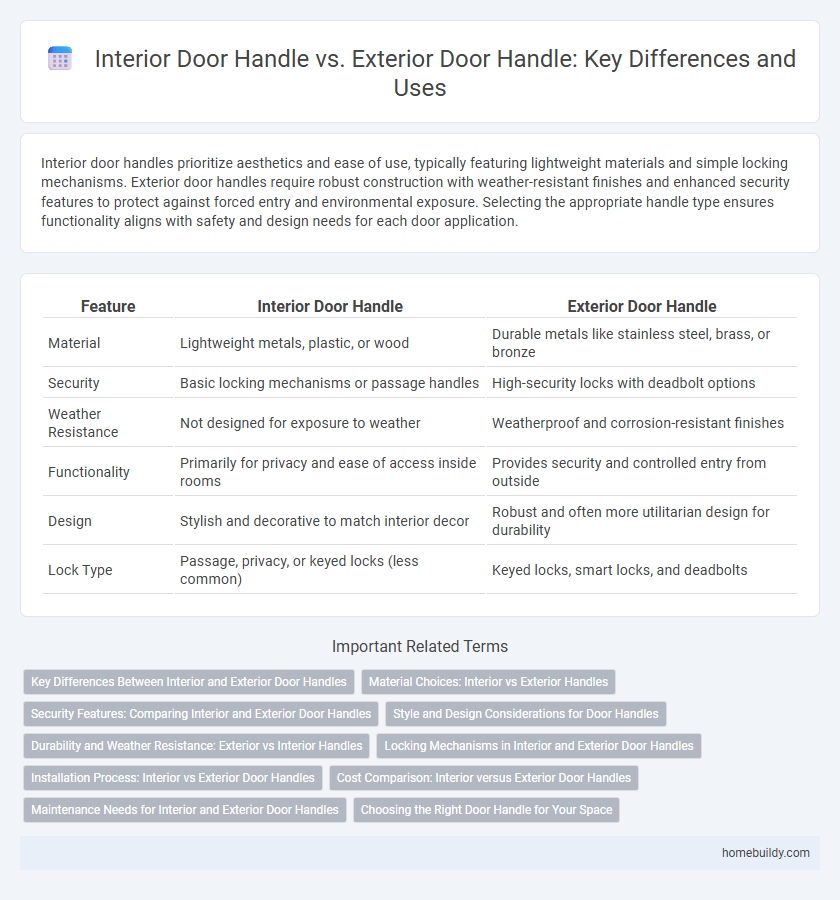Interior door handles prioritize aesthetics and ease of use, typically featuring lightweight materials and simple locking mechanisms. Exterior door handles require robust construction with weather-resistant finishes and enhanced security features to protect against forced entry and environmental exposure. Selecting the appropriate handle type ensures functionality aligns with safety and design needs for each door application.
Table of Comparison
| Feature | Interior Door Handle | Exterior Door Handle |
|---|---|---|
| Material | Lightweight metals, plastic, or wood | Durable metals like stainless steel, brass, or bronze |
| Security | Basic locking mechanisms or passage handles | High-security locks with deadbolt options |
| Weather Resistance | Not designed for exposure to weather | Weatherproof and corrosion-resistant finishes |
| Functionality | Primarily for privacy and ease of access inside rooms | Provides security and controlled entry from outside |
| Design | Stylish and decorative to match interior decor | Robust and often more utilitarian design for durability |
| Lock Type | Passage, privacy, or keyed locks (less common) | Keyed locks, smart locks, and deadbolts |
Key Differences Between Interior and Exterior Door Handles
Exterior door handles are designed with enhanced security features such as reinforced materials, integrated key locks, and weather-resistant finishes to withstand outdoor elements and protect against forced entry. Interior door handles prioritize ease of use and aesthetic appeal, often featuring simpler latch mechanisms, a variety of styles, and finishes that complement indoor decor without the need for heavy-duty security. These functional and material distinctions are critical for selecting the appropriate handle type based on location and security requirements.
Material Choices: Interior vs Exterior Handles
Interior door handles commonly feature materials like brass, stainless steel, or zinc alloys designed for aesthetic appeal and moderate durability, while exterior door handles often utilize heavy-duty metals such as solid brass, bronze, or stainless steel with weather-resistant finishes to withstand outdoor elements. Exterior handles incorporate coatings like powder coating or anodizing to prevent corrosion, whereas interior handles prioritize smooth finishes and ergonomic designs. Material selection directly impacts longevity, security, and maintenance requirements for both interior and exterior applications.
Security Features: Comparing Interior and Exterior Door Handles
Exterior door handles are equipped with advanced security features such as reinforced materials, tamper-resistant designs, and integrated locking mechanisms to prevent unauthorized access. In contrast, interior door handles prioritize ease of use and privacy, often featuring simple locksets or push-button locks without heavy security reinforcements. Selecting the appropriate handle type depends on balancing security needs with functional requirements for each door location.
Style and Design Considerations for Door Handles
Interior door handles prioritize sleek, ergonomic designs that complement indoor decor, often featuring polished finishes like brushed nickel or brass to blend seamlessly with room aesthetics. Exterior door handles emphasize durability and security, incorporating weather-resistant materials such as stainless steel or bronze, with styles ranging from classic to modern to enhance curb appeal. Both types balance functionality with visual appeal, but exterior handles typically include locking mechanisms and robust construction to withstand environmental factors.
Durability and Weather Resistance: Exterior vs Interior Handles
Exterior door handles are engineered with durable materials like stainless steel, brass, or zinc alloys, ensuring high resistance to weather elements such as rain, UV rays, and temperature fluctuations. Interior door handles prioritize aesthetics and functionality within controlled environments, often utilizing less robust materials like plastic or lightweight metal alloys that lack weatherproof coatings. The superior weather resistance and corrosion protection of exterior handles make them essential for maintaining security and longevity in outdoor conditions.
Locking Mechanisms in Interior and Exterior Door Handles
Interior door handles typically feature simple locking mechanisms such as privacy locks or passage latches, designed for ease of use and basic security within a home. Exterior door handles incorporate more robust locking systems, including deadbolts and keyed locks, to provide enhanced security against unauthorized entry. High-security exterior handles may also integrate smart lock technology with biometric or keypad access for advanced protection.
Installation Process: Interior vs Exterior Door Handles
Interior door handles typically feature simpler installation processes with fewer components, such as latch mechanisms and basic screws, allowing for quick mounting on hollow or solid wooden doors. Exterior door handles require more complex installation involving reinforced plates, deadbolts, and weather-resistant materials to ensure security and durability against environmental factors. Proper alignment and secure fastening are critical for exterior handles to support locking functions, often necessitating professional installation or advanced tools.
Cost Comparison: Interior versus Exterior Door Handles
Interior door handles typically cost between $10 and $50, while exterior door handles range from $30 to over $200 due to enhanced security features and weather-resistant materials. Exterior handles often include keyed locks and durable finishes to withstand outdoor elements, driving up their price compared to interior handles designed mainly for aesthetic and convenience purposes. Choosing between them depends on budget considerations and the required level of security and durability for the door's location.
Maintenance Needs for Interior and Exterior Door Handles
Interior door handles require minimal maintenance, typically limited to occasional cleaning and lubrication to ensure smooth operation. Exterior door handles demand more frequent upkeep, including weather-resistant treatments and regular inspections to prevent rust, corrosion, and damage from exposure to elements. Proper maintenance extends the lifespan of both types, with exterior handles needing more durable materials like stainless steel or brass for enhanced durability.
Choosing the Right Door Handle for Your Space
Interior door handles prioritize comfort, style, and ease of use, often featuring lever designs and finishes that complement indoor decor. Exterior door handles emphasize security, durability, and weather resistance, commonly incorporating robust materials like stainless steel or brass and advanced locking mechanisms. Choosing the right door handle involves balancing aesthetic preferences with functional requirements specific to either indoor or outdoor environments.
interior door handle vs exterior door handle Infographic

 homebuildy.com
homebuildy.com